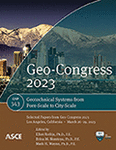Experimental Study on Continuous and Oscillatory Rotational Penetration
Publication: Geo-Congress 2023
ABSTRACT
“Wiggling,” rotational and oscillatory motions are often adopted by many living organisms to penetrate into or burrow in the soil. For example, seeds of the Erodium cicutarium and Pelargonium can bury themselves into the ground for future germination with a continuous rotational motion. The angled worm lizards (Agamodon anguliceps) make tunnels by oscillating their head along the long axis of the trunk. Our previous numerical simulations indicate that both rotational modes lead to comparable reductions of penetration resistance of a rod with a conical tip. In this study, both modes of rotational penetration were further investigated through laboratory experiments. The penetrator consists of a cylindrical shaft and a conical tip with an apex angle of 60°. A gear motor is integrated into the penetrator for rotational motion control: both continuous rotation and oscillatory rotation can be achieved. The penetrator assembly is connected to a six-axis robotic arm, which controls the vertical penetration and collects the force/displacement data. A series of rotational penetration tests were conducted in Ottawa sand F65 with different combinations of vertical and rotational velocities while the resultant velocity was kept as a constant. Different oscillation amplitudes were used under the same rotational velocity for the oscillatory rotational penetration cases. The results confirmed the conclusions drawn from the numerical simulations: for both rotational penetration modes, the rotational penetration forces decrease with the relative slip velocity (ratio between the rotational and vertical velocity); comparing with the non-rotational case, the reduction of penetration force is about 80% for the whole-body-continuous-rotation (WCR) case and 60% for the cone-continuous-rotation (CCR) and cone-oscillatory-rotation (COR) when the relative slip velocity reaches 20. Under the tested conditions, the penetration forces were not affected by the oscillation amplitudes. Comparing with continuous rotational penetration, oscillatory penetration achieved less reduction of penetration force, but it is easier to be implemented in cone penetration tests or self-burrowing robots.
Get full access to this article
View all available purchase options and get full access to this chapter.
REFERENCES
Abraham, Y., and R. Elbaum. 2013b. “Hygroscopic movements in Geraniaceae: The structural variations that are responsible for coiling or bending.” New Phytologist, 199 (2): 584–594. https://doi.org/10.1111/nph.12254.
Abraham, Y., and R. Elbaum. 2013a. “Hygroscopic movements in Geraniaceae: The structural variations that are responsible for coiling or bending.” New Phytologist, 199 (2): 584–594. https://doi.org/10.1111/nph.12254.
Cogger, H. G., R. G. Zweifel, and D. Kirshner. 1998. Encyclopedia of reptiles & amphibians. Weldon Owen.
Dorgan, K. M. 2015. “The biomechanics of burrowing and boring.” Journal of Experimental Biology, 218 (2): 176–183. https://doi.org/10.1242/jeb.086983.
Evangelista, D., S. Hotton, and J. Dumais. 2011. “The mechanics of explosive dispersal and self-burial in the seeds of the filaree, Erodium Cicutarium (Geraniaceae).” Journal of Experimental Biology, 214 (4): 521–529. https://doi.org/10.1242/jeb.050567.
Gans, C. 1968. “Relative Success of Divergent Pathways in Amphisbaenian Specialization.” The American Naturalist, 102 (926): 345–362. The University of Chicago Press. https://doi.org/10.1086/282548.
Huang, S., and J. Tao. 2020. “Modeling Clam-inspired Burrowing in Dry Sand using Cavity Expansion Theory and DEM.” Acta Geotechnica, 15 (8): 2305–2326. https://doi.org/10.1007/s11440-020-00918-8.
Maladen, R. D., Y. Ding, C. Li, and D. I. Goldman. 2009. “Undulatory Swimming in Sand: Subsurface Locomotion of the Sandfish Lizard.” Science, 325 (5938): 314–318. https://doi.org/10.1126/science.1172490.
Maladen, R. D., Y. Ding, P. B. Umbanhowar, and D. I. Goldman. 2011a. “Undulatory swimming in sand: Experimental and simulation studies of a robotic sandfish.” The International Journal of Robotics Research, 30 (7): 793–805. SAGE Publications Ltd STM. https://doi.org/10.1177/0278364911402406.
Maladen, R. D., Y. Ding, P. B. Umbanhowar, A. Kamor, and D. I. Goldman. 2011b. “Mechanical models of sandfish locomotion reveal principles of high performance subsurface sand-swimming.” Journal of The Royal Society Interface. The Royal Society. https://doi.org/10.1098/rsif.2010.0678.
Migliaccio, F., P. Tassone, and A. Fortunati. 2013. “Circumnutation as an autonomous root movement in plants.” American Journal of Botany, 100 (1): 4–13. https://doi.org/10.3732/ajb.1200314.
Stamp, N. E. 1984. “Self-Burial Behaviour of Erodium Cicutarium Seeds.” Journal of Ecology, 72 (2): 611–620. [Wiley, British Ecological Society]. https://doi.org/10.2307/2260070.
Tang, Y., and J. Tao. 2022a. “Multiscale analysis of rotational penetration in shallow dry sand and implications for self-burrowing robot design.” Acta Geotechnica. https://doi.org/10.1007/s11440-022-01492-x.
Tang, Y., and J. J. Tao. 2022b. Effect of Rotational Cone on Penetration Resistance and Its Implication to the Design of a Bio-Inspired Self-Burrowing Robots. 214–222. American Society of Civil Engineers. https://doi.org/10.1061/9780784484036.022.
Trueman, E. R., and M. Yonge. 1967. “The dynamics of burrowing in Ensis (Bivalvia).” Proceedings of the Royal Society of London. Series B. Biological Sciences, 166 (1005): 459–476. Royal Society. https://doi.org/10.1098/rspb.1967.0007.
Winter, A. G., V. R. L. H. Deits, D. S. Dorsch, A. H. Slocum, and A. E. Hosoi. 2014. “Razor clam to RoboClam: Burrowing drag reduction mechanisms and their robotic adaptation.” Bioinspiration & Biomimetics, 9 (3): 036009. https://doi.org/10.1088/1748-3182/9/3/036009.
Information & Authors
Information
Published In
History
Published online: Mar 23, 2023
Authors
Metrics & Citations
Metrics
Citations
Download citation
If you have the appropriate software installed, you can download article citation data to the citation manager of your choice. Simply select your manager software from the list below and click Download.
